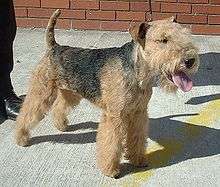Lakeland Terrier
The Lakeland Terrier is a dog breed, which takes its name from its place of origin,[1] the Lake District in England. The dog is a small to mid-size member of the Terrier family. While independent in personality, it interacts well with owners and all family members,[2] and is mostly hypo-allergenic (non shedding).[3] In the United Kingdom, the Lakeland Terrier is considered a vulnerable dog breed at risk of going extinct through low levels of breeding, according to The Kennel Club.[4] And in the United States in 2018 the Lakeland Terrier ranked 147 out of 193 breeds by number of American Kennel Club puppy registrations.[5]
| Lakeland Terrier | |||||||||
|---|---|---|---|---|---|---|---|---|---|
 Black and tan Lakeland Terrier | |||||||||
| Origin | United Kingdom (England) | ||||||||
| |||||||||
| Dog (domestic dog) | |||||||||
Description
Appearance
At 15–17 lb (7–8 kg), it is the smallest of the long legged, black and tan terriers.[2] The Lakeland is similar in appearance to the slightly larger Welsh Terrier but is finer-boned.[2] The largest of the threesome in this similar group of Terriers is the Airedale.[2] The Lakeland is a sturdy dog,[6] compact, free moving and able to cover ground with little effort and much quickness.[2] The dog is relatively narrow in the chest and has a broad muzzle, yet slightly narrower than the Welsh Terrier, with small, V-shaped ears.[2] The Lakeland breed has a thick bushy wiry outer coat and a soft undercoat.[6] It comes in a variety of colors though The Kennel Club lists the following as 'Acceptable colours for registration': Black, Black and Tan, Blue and Tan, Dark Grizzle, Grizzle, Grizzle and Tan, Liver and Tan, Red, Red Grizzle, Wheaten.[7] They have an upright tail which was previously customarily docked.[6] Lakeland Terriers grow to between 33 and 38 cm (13 to 15 inches) in height[8] measured to the withers.

The eyes are small and dark colored and of oval shape.[2] The nose and pads of the feet are black except in liver colored dogs where the nose and pad coloring will be liver colored.[2] Liver colored dogs will have a slightly lighter colored eye.[2] The dog will not shed if properly groomed.[9] It is suggested that "Regular stripping and trimming improves the texture and quality of the coat" and is "necessary to enhance the dog's utilitarian purposes" as well as "enhancing him for the show ring".[10]
Temperament
The dogs are friendly, bold, and confident.[3] Shyness is very atypical, as is aggressiveness.[2] Very intelligent and independent minded, they are quick to learn and easy to train though Lakelands often exhibit 'selective deafness' when their interest level is aroused.[2] The Lakeland is quite receptive to crate training.[2] As with most terriers, the Lakeland is energetic; daily exercise and playtimes are a must, lest this active dog seek other outlets for their energy, with undesirable results for the owner.[2]
History

The UK Kennel Club claims to have recognised Lakeland Terriers in 1921,[3] whereas the Lakeland Terrier Club suggests this was closer to 1928.[1] The Lakeland Terrier Association (now defunct) was founded in 1921.[1] In 1925 the breed attained homogeneity following a cross-breeding with the Fox Terrier and the Airedale Terrier.[2] The Lakeland Terrier Club was founded in 1932[1] and promoted the breed nationally[1] through Kennel-Club sanctioned shows.[2] In the Lake District of the UK, the mountainous, rocky terrain is unsuitable for hunting fox on horseback and foxes were hunted on foot.[2] It has been suggested that the Lakeland Terrier's great stamina derives from running all day with the hounds, unlike his close cousin, the fox terrier, who would have been carried in a saddle bag to be released only when the fox had gone to earth.[2]
As one of the earliest Terriers (Latin derivation of earth), dating from the 1700s, this "earth" dog is a descendant of the old English Black and Tan and Fell Terriers.[2] The Lakeland's original service was "going to ground" on the farm in hunt for vermin. Its size and energy make it popular as a hunter in hard to reach places; the breed is among those eligible for competition in sanctioned Earthdog trials.
The working dog version of the Lakeland is often known as the Fell Terrier or Patterdale Terrier. Whereas most terrier breeds have only to bolt their quarry, or to mark it by baying, the Lakeland must be able to kill the foxes in their lair.[2]
Famous Lakelands
- Stingray of Derryabah - the first dog to win Best in Show/Supreme Champion at both the top US and UK shows Westminster and Crufts (1967)[11]
- Zelda Van Gutters - Nickelodeon Magazine's Roving Reporter/Mascot
- Champion Revelry's Awesome Blossom - Top winning Lakeland Terrier owned by Jean L. Heath and Bill Cosby[12]
- Kevin, owned by Neil Tennant (Singer of the Pet Shop Boys)[13]
References
- Lakeland Terrier Club Archived 2012-03-12 at the Wayback Machine Origin and history
- Alderton, David (1993). Dogs, p.214. Dorling Kindersley. ISBN 1-56458-176-4.
- The Kennel Club Breed Information Centre, Lakeland Terrier
- "Vulnerable native breeds". www.thekennelclub.org.uk.
- "Most Popular Breeds". American Kennel Club.
- The Kennel Club Breed Standard
- The Kennel Club Breed Information Centre, Lakeland Terrier, Acceptable Colours for Registration
- Lakeland Terrier Club Archived 2012-03-12 at the Wayback Machine Appearance
- "Grooming the Pet Lakeland". U.S. Lakeland Terrier Club. Archived from the original on February 18, 2009. Retrieved May 9, 2011.
- US Lakeland Terrier Club Archived 2012-02-21 at the Wayback Machine For the Show Ring
- Punter, Ron (2007), "The Lakeland Terrier Ch Stingray of Derryabah 40 years ago first dog to win BIS at both Crufts and Westminster", archived from the original on 7 September 2015, retrieved 4 April 2014
- Green, Ranny (9 February 1997), "Schnauzer, Dobe Lead Way At Westminster", The Seattle Times, retrieved 4 April 2014
- Pet Shop Boys Official Site Pet Texts, 21 April 2007